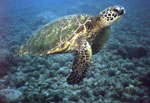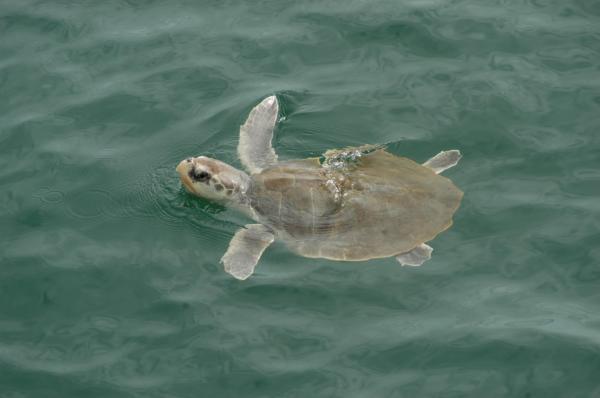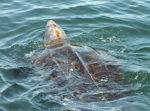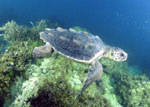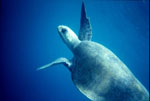Marine Turtles
Marine Turtle Species | Conservation & Management | Recovery Plans | Five-Year Reviews |Threats | Bycatch | Regulations | Permits | Symposia | Publications | More Info
Overview
Sea turtles, air-breathing reptiles with streamlined bodies and large flippers, are well adapted to life in the marine environment. They inhabit tropical and subtropical ocean waters throughout the world. Of the seven species of sea turtles, six are found in U.S. waters: green, hawksbill, Kemp's ridley, leatherback, loggerhead, and olive ridley.
Although sea turtles live most of their lives in the ocean, adult females must return to beaches on land to lay their eggs. They often migrate long distances between foraging grounds and nesting beaches.
Status of Marine Turtles
All 7 species of marine turtles are listed under the Endangered Species Act (ESA); 6 of those species fall under the jurisdiction of the NOAA Fisheries Office of Protected Resources. Green turtles and olive ridley turtles have breeding populations that were listed separately under the ESA, and therefore, have more than one ESA status.
(E = "endangered"; T = "threatened")
| Species |
Status |
|
- Florida & Mexico's Pacific coast breeding colonies
|
E |
|
T |
|
E |
|
E |
|
E |
|
T |
|
- Mexico's Pacific coast breeding colonies
|
E |
|
T |
Marine Turtle Conservation and Management
All six species of sea turtles occurring in the U.S. are protected under the Endangered Species Act of 1973. NOAA Fisheries and the U.S. Fish and Wildlife Service (USFWS) share jurisdiction for sea turtles, with NOAA Fisheries having lead responsibility for the conservation and recovery of sea turtles in the marine environment and USFWS for turtles on nesting beaches.
Threats
Major threats to sea turtles in the U.S. include, but are not limited to: destruction and alteration of nesting and foraging habitats; incidental capture in commercial and recreational fisheries; entanglement in marine debris; and vessel strikes. To reduce the incidental capture of sea turtles in commercial fisheries, NOAA Fisheries has enacted regulations to restrict certain U.S. commercial fishing gears (gillnets, longlines, pound nets, and trawls) that have known, significant bycatch of sea turtles. To effectively address all threats to marine turtles, NOAA Fisheries and the USFWS have developed recovery plans to direct research and management efforts for each sea turtle species. More information on threats to marine turtles is available.
International Conservation
The conservation and recovery of sea turtles requires multi-lateral cooperation and agreements to ensure the survival of these highly migratory animals. NOAA Fisheries has a broad national and international program for the conservation and recovery of marine turtles, such as the Indian Ocean - South-East Asian Marine Turtle Memorandum of Understanding (IOSEA). In the Office of Protected Resources, the goals of the international component of the sea turtle program are to facilitate the global conservation and recovery of sea turtles by working closely with other nations through diplomatic channels, capacity building and scientific exchange. The Office of Protected Resources also coordinates closely with our Regional Office staff and Science Center staff who are involved in international activities related to sea turtle research and management.
More Info
|
